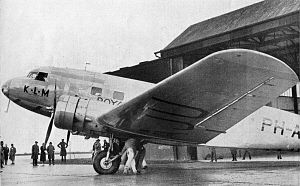DC-2
| DC-2 | |
|---|---|
 |
|
| DC-2 PH-AJU Uiver came second in the MacRobertson Air Race | |
| Role | Passenger & military transport |
| Manufacturer | Douglas Aircraft Company |
| First flight | May 11, 1934 |
| Introduction | May 18, 1934 with Trans World Airlines |
| Status | Retired |
| Primary users |
Transcontinental & Western Air (TWA) KLM Pan American Airways |
| Produced | 1934–1939 |
| Number built | 198 |
| Developed from | Douglas DC-1 |
| Developed into |
B-18 Bolo Douglas DC-3 |
The Douglas DC-2 is a 14-seat, twin-engined airliner that was produced by the American company Douglas Aircraft Corporation starting in 1934. It competed with the Boeing 247. In 1935, Douglas produced a larger version called the DC-3, which became one of the most successful aircraft in history.
In the early 1930s, fears about the safety of wooden aircraft structures drove the US aviation industry to develop all-metal airliners. United Airlines had exclusive right to the all metal twin-engine Boeing 247; rival TWA issued a specification for an all-metal trimotor.
The Douglas response was more radical. When it flew on July 1, 1933, the prototype DC-1 had a robust tapered wing, retractable landing gear, and two 690 hp (515 kW) Wright radial engines driving variable-pitch propellers. It seated 12 passengers.
TWA accepted the basic design and ordered twenty of the upgraded DC-2s which were longer, had more powerful engines, and carried 14 passengers in a 66-inch-wide cabin. The design impressed American and European airlines and further orders followed. Although Fokker had purchased a production licence from Douglas for $100,000, no manufacturing was done in Holland. Those for European customers KLM, LOT, Swissair, CLS and LAPE purchased via Fokker in the Netherlands were built and flown by Douglas in the US, sea-shipped to Europe with wings and propellers detached, then erected at airfields by Fokker near the seaport of arrival (e.g. Cherbourg or Rotterdam).,Airspeed Ltd. took a similar licence for DC-2s to be delivered in Britain and assigned the company designation Airspeed AS.23, but although a registration for one aircraft was reserved none were built. Another licence was taken by the Nakajima Aircraft Company in Japan; unlike Fokker and Airspeed, Nakajima built five aircraft as well as assembling at least one Douglas-built aircraft. A total of 130 civil DC-2s were built with another 62 for the United States military. In 1935 Don Douglas stated in an article that the DC-2 cost about $80,000 per aircraft if mass-produced.
...
Wikipedia
